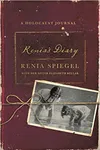Imagine a teenage poet capturing love, fear, and resilience in a world crumbling under war—meet Renia Spiegel! This Polish-Jewish diarist, often compared to Anne Frank, penned a heart-wrenching diary during the Holocaust. Her vivid prose and poetry, written under Nazi occupation, offer a raw, youthful lens on a dark era, making her a timeless voice of courage.
Born in 1924, Renia’s diary, published decades after her tragic death at 18, has captivated readers worldwide. It’s not just a historical record; it’s a vibrant story of a girl navigating adolescence amidst unimaginable horror. Ready to dive into her world?
The Making of Renia Spiegel
Renia Spiegel was born on June 18, 1924, in Uhryńkowce, Poland (now Ukraine), to a Jewish family. Raised in a loving household with her younger sister Ariana (later Elizabeth Bellak), Renia’s early years were filled with nature and creativity. When war broke out in 1939, she and Ariana were staying with their grandparents in Przemyśl, separated from their mother in Nazi-occupied Warsaw. This separation sparked Renia’s need for a confidant, leading her to start her diary at 15—a notebook that became her closest friend.
Living under Soviet and later Nazi rule, Renia’s world shifted dramatically. Yet, her passion for poetry and storytelling shone through, even as she faced increasing persecution. Her diary entries blend the mundane joys of teenage life with the creeping dread of war, showcasing her remarkable ability to find beauty in chaos.
Renia Spiegel’s Unforgettable Diary
Renia’s primary work, Renia’s Diary: A Holocaust Journal, is a nearly 700-page testament to her life from 1939 to 1942. Published in English in 2019, it chronicles her experiences in Przemyśl under Soviet and Nazi occupation. The diary captures her school days, friendships, and first love with Zygmunt Schwarzer, alongside the horrors of ghetto life and Nazi violence. Her writing style is intimate and lyrical, blending prose with poignant poetry that reflects her hopes and fears.
Unlike Anne Frank’s diary, written in hiding, Renia’s unfolds in the open world of Przemyśl, offering a unique perspective on both Soviet and Nazi regimes. Entries like “Wherever I look, there is bloodshed” reveal the war’s toll, while poems about love and nature show her resilience. Her final entry, a plea to God for survival, was followed by Zygmunt’s heartbreaking note after her execution: “Three shots! Three lives lost!”
The diary’s publication, driven by her sister and niece, has inspired a documentary, Broken Dreams, and a stage production, Witnesses. Renia’s words also form the basis of an educational project by the Galicia Jewish Museum, using films to teach empathy and human rights.
Why Renia Spiegel Matters
Renia’s diary is more than a Holocaust memoir; it’s a universal story of youth, love, and survival. Her ability to weave everyday teenage struggles with the atrocities around her makes her work profoundly relatable. Scholars praise her literary talent, with some calling her a “Polish Anne Frank” for her vivid, emotional storytelling. Her diary has become a vital historical source, shedding light on the Jewish experience in Przemyśl and the human cost of war.
Today, Renia’s legacy lives on through the Renia Spiegel Foundation, which promotes her work and supports young poets via a poetry competition. Her story reminds us of the power of words to preserve memory and inspire tolerance, especially in a world grappling with division. As her niece Alexandra Bellak notes, Renia’s voice is a call to confront hate and cherish humanity.
- Born: June 18, 1924, Uhryńkowce, Poland
- Key Work: Renia’s Diary: A Holocaust Journal (2019)
- Notable Recognition: Compared to Anne Frank, subject of Broken Dreams documentary
- Legacy: Inspires educational projects and poetry competitions
Grab Renia’s Diary and step into the world of a brave, poetic soul whose words still echo with hope and heart!
